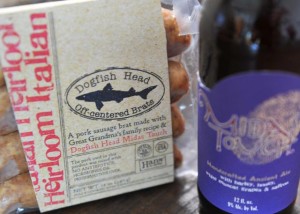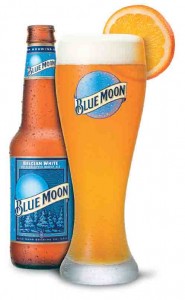
For Calagione, this meant line-extending beyond the beer category altogether. So he turned to brats. Besides the typical German beer hall fare, the company’s recently announced foray into food also includes clam chowder and pickles flavored with hops. The impetus, Calagione claims, was driven largely by the opportunity to build cross-category retail sets.
“We began this process with our beer-wine hybrid racks, which are placed in wine sections and feature our wine-centric beers like Noble Rot, Sixty-One and Midas Touch,” he said. “Now we are setting up cross-displays that feature brats, chowder cans, pickle jars and the Dogfish beers that best pair with each item.”
Making your own branded bratwurst is kind of an extreme way to get real estate near the meat counter, but that doesn’t mean that other beer companies aren’t angling for the same address. And the retailers are eager for them to move in, as well.
“High-end grocery and specialty outlets that are familiar with craft brands understand the value of trying to merchandise the beer category throughout a store,” said Tom Fox, a national category management expert and partner with CM Profit Group.
Fox believes that additional points of purchase not only encourage consumer trial but also increases the likelihood of craft beer making it to the checkout line.
“Anytime you can get a secondary point of purchase placement, there is a lot of data that suggests it will drive more velocity,” he said.
But it’s not as simple as walking into a Kroger or Safeway and asking the butcher for space in front of his meat counter. Steve Zulanas, the vice president of sales for Allied Beverages, a Los Angeles-based beer wholesaler, said that craft brewers need to explain to individual department buyers how cross-merchandised placements can improve a department’s bottom line.
“The flexibility of the store manager position has diminished and they have less decision-making power than they used to,” he said. “But that doesn’t mean craft brewers can’t be successful in every department. They just need to understand what the department buyers’ goals are.”

A good cross merchandising strategy will satisfy retailers’ need to maximize the profitability of their store layout.
“A 750 mL bottle of beer is more profitable — per square foot — than a bottle of wine because it will turn two-to-three times faster,” said Zulanas. “But there still has to be a natural tie-in if you’re merchandising beyond the beer aisle. If you have an excellent hoppy beer, figure out what it pairs well with and go sell a buyer on the idea.”
Fox agreed but said that craft brewers — while passionate and great at storytelling — lack the skill sets and information needed to properly explain the profitability equation to retailers.
“The stories alone aren’t going to get you secondary retail placements,” he said. “They need to show what is going on in the category, explain why it makes sense and show the financial impact for the retailer.”
That financial impact is something that recent IRI data could help explain. For the year-to-date period ending May 19, the Chicago-based retail information supplier pegs craft dollar sales up 15 percent in total U.S. food channels with nearly $394 million in sales. Craft’s growth is second only to progressive adult beverages, dollar sales of which are up 46 percent, to over $126 million, in the same period.
And even though craft also still trails imports — a category that boasts $609 million so far this year — it’s gaining ground. Import brands are, collectively, up just one percent in the IRI-tracked food channel.
